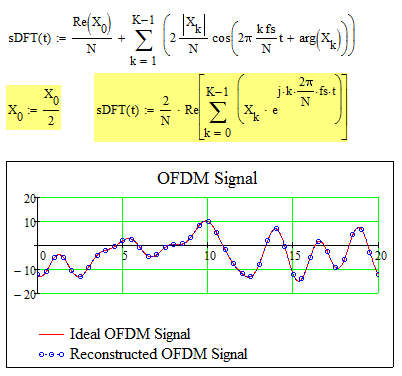- Subscribe to RSS Feed
- Mark Topic as New
- Mark Topic as Read
- Float this Topic for Current User
- Bookmark
- Subscribe
- Mute
- Printer Friendly Page
OFDM Signal Reconstruction via DFT
- Mark as New
- Bookmark
- Subscribe
- Mute
- Subscribe to RSS Feed
- Permalink
- Notify Moderator
OFDM Signal Reconstruction via DFT
I'm having trouble reconstructing an OFDM QAM signal using its amplitude and phase spectra obtained by using the DFT. The QAM signal is given in the image below.
I have tried to do it so far using the below equation.
This is the closest I have reconstructed it to the original. What am I missing?
I am using Mathcad 13.
- Mark as New
- Bookmark
- Subscribe
- Mute
- Subscribe to RSS Feed
- Permalink
- Notify Moderator
You sure would get a better respones if you attach a worksheet. From the pic alone probably nobody would be able to determine what the problem ould be.
Would the following link be of any help?
http://www.comlab.hut.fi/users/tko/geta07/GETA fall 07- OFDM with MathCAD.ppt
- Mark as New
- Bookmark
- Subscribe
- Mute
- Subscribe to RSS Feed
- Permalink
- Notify Moderator
No sorry that doesn't help. I was browsing through that just last night actually. I have attached my worksheet.
- Mark as New
- Bookmark
- Subscribe
- Mute
- Subscribe to RSS Feed
- Permalink
- Notify Moderator
Jonathan Mayers wrote:
No sorry that doesn't help. I was browsing through that just last night actually. I have attached my worksheet.
Was just a try.
So hopefully someone with better technical background could jump in.
BTW,
- are you sure about the absolute value of X0 in the definition of sDFT(t)?
- could it be that you used the wrong vector X in the last definition? You redefined X in the Spectral Analyisis section.
- Mark as New
- Bookmark
- Subscribe
- Mute
- Subscribe to RSS Feed
- Permalink
- Notify Moderator
1. Yes. The DC value is part of the reconstruction.
2. No. The last definition of X is what I'm supposed to use.
- Mark as New
- Bookmark
- Subscribe
- Mute
- Subscribe to RSS Feed
- Permalink
- Notify Moderator
Jonathan Mayers wrote:
1. Yes. The DC value is part of the reconstruction.
2. No. The last definition of X is what I'm supposed to use.
OK, so I'm not of much help. It was just that I thought that
1) the DC value could be (is) negative!?
and I noticed that
2) you are using just the first 10 values of the 200 element vector X in the definition of sDFT for reconstruction. Obviously thats supposed to be done.
- Mark as New
- Bookmark
- Subscribe
- Mute
- Subscribe to RSS Feed
- Permalink
- Notify Moderator
Yes because after the first K components, all others are zero and do not affect the calculation. The DC value is positive for me so I'm not sure what you mean. However, I changed the equation up a bit and instead I put my DC value to be negative and the two signals overlay exactly. For anyone who may be in a similar situation, find attached the mathcad 13 worksheet.
- Mark as New
- Bookmark
- Subscribe
- Mute
- Subscribe to RSS Feed
- Permalink
- Notify Moderator
Ah yes, that makes sense, especially if you think of the reconstruction in its complex form
BTW, I think your DC should be X0/N (without the absolute value) or even better Re(X0)/N so you are prepared if cause of numeric errors you get an imaginary part in X0.






